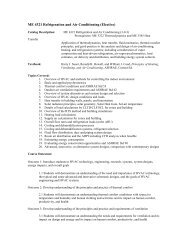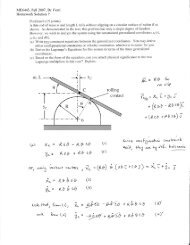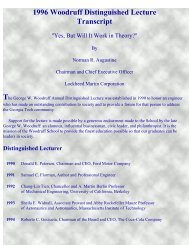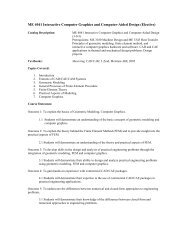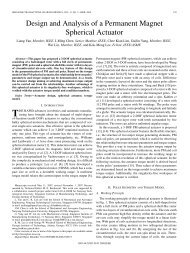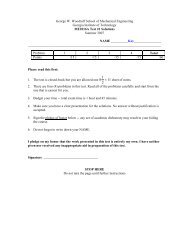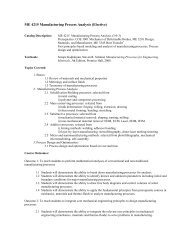Homework #2 Solution
Homework #2 Solution
Homework #2 Solution
You also want an ePaper? Increase the reach of your titles
YUMPU automatically turns print PDFs into web optimized ePapers that Google loves.
<strong>Homework</strong> <strong>#2</strong> <strong>Solution</strong>1) B-3-13T 1θ ι θ ο θ οJkT 1θ οθ ο0T 2T 2Combining these equations,T= kJ & θ 0= T1− T2( θ −θ)T &2= bθ 1 i o,0J & θ + b & θ + kθ= kθoooi2) B-3-15Done in class.3) Derive a mathematical model for the system shown in the figure 5-45 of the text. Displacements y 1 and y 2 aremeasured from respective equilibrium positions.
4) We solve this problem using the conservation of energy. Ignoring losses, we have E 1 =E 2 .E 1 =mgh=mgL(1-cos(θ 0 )) (potential energy measured from the lowest mass height when the pendulum is vertical).E 2 =mv 2 /2. Equating the two gives, v=(2gL(1-cos(θ 0 ))) 1/2 and dθ/dt=v/L=(2g(1-cos(θ 0 ))/L) 1/2 .5)
The dissipated power is B 1 ω 1 2 + B 2 ω 2 2 =10(120π) 2 +10(4π) 2 =1422 KW (unrealistic).6)Step 1: The free-body-diagram of the system is given below:BT BT 12T k0Kθ 1T kT 21θ 1T iFT 12=r 1FT 21=r 2FF0θ 2T lJ 1θ 2J2Step 2: Constitutive relationships:J1: J &&1θ1= Ti−TB−T12(1)(CCW+)gear ( n = r2 / r1):B : T = Bθ&B 1(2)TJ2: J &2θ 21= nT12( 3)2= T21− T k− TL(5) (CW+)θ2 = ( 1/ n) θ1( 4)Step 3:K: Tk= Kθ 2( 6 )Combining eqs. (1) & (2), and eqs. (5) & (6) gives:J &&1θ1+ Bθ&1+ T12= Ti(7)J &&2θ2+ Kθ2+ TL= T21(8)To find T 21, substitute T 12from eq. (7) into (3) to get:by eq. (4)T21 = n( T − J &1θ1− Bθ&1)= n(T − nJ &&1θ2− nBθ&ii1)(9)Substituting for T 2from eq. (9) into (8) gives:22J &effθ2+ ( n B)θ&2+ Kθ2= nTi−TL, Jeff= J2+ n J1This is equivalent to a mass spring damper with inertia J eff, spring constant K , and damping coefficient n B2 .



